Overview
The article titled "10 Programs for Kids with Autism to Enhance Skills and Support" shines a light on various programs thoughtfully designed to improve skills and provide crucial support for children with autism. It highlights engaging activities such as:
- Role-playing
- Mindfulness exercises
- Sensory activities
These activities effectively foster communication, social skills, and emotional regulation. This nurturing approach significantly enhances the quality of life for children with autism and their families, offering hope and practical resources for those navigating these challenges together.
Introduction
Navigating the world of autism can be a complex journey for both children and their families. Yet, with the right programs, challenges can transform into opportunities for growth and connection. This article explores ten innovative programs designed specifically for kids with autism, each aimed at enhancing essential skills and providing critical support.
How can these tailored interventions not only improve communication and social interactions but also foster a sense of belonging and empowerment in young individuals with autism? Delving into this question reveals a wealth of resources that promise to make a meaningful difference in their lives.
About ASD Media: Empowering Parents and Professionals in Autism Support
ASD Media is at the forefront of enhancing ABA therapy implementation, offering vital insights and strategies to tackle challenges and improve outcomes for individuals with ADHD and related conditions. This organization is committed to nurturing a supportive and inclusive community where parents and professionals can share their experiences, learn from each other, and receive invaluable support on their journeys. By subscribing to their newsletter, individuals can access the latest news and unlimited digital resources, empowering them to unlock the potential of youth with autism through programs for kids with autism.
The impact of ABA therapy is truly remarkable, with studies showing that early intervention can lead to significant improvements in communication and social skills. In fact, up to 90% of young individuals receiving early intervention develop functional communication skills. ASD Media provides effective strategies for managing challenging behaviors and navigating support services, highlighting the importance of tailored approaches that cater to each individual's unique strengths and needs. Notably, around 30% to 60% of individuals with ASD are also diagnosed with ADHD, underscoring the necessity for personalized approaches in therapy.
Current trends in ABA therapy reveal a growing demand for certified therapists, with job growth projected to exceed 20% by 2029. This increase signifies a rising recognition of the importance of community in supporting individuals with developmental disorders. Expert opinions reinforce that a collaborative environment enhances the effectiveness of ABA therapy. As Julian Hannush wisely notes, "Early developmental disorder diagnosis, intervention, and treatment can be lifesaving," emphasizing the critical role of timely support.
Moreover, over 80% of families report an enhanced quality of life and reduced stress following early intervention, further highlighting the positive impact of programs for kids with autism. ASD Media's mission is to empower families and professionals alike, ensuring they have the tools and resources necessary to foster interpersonal skills development and improve the overall quality of life for youngsters with ADHD. Furthermore, the economic implications of developmental disorder care are significant, with expenses anticipated to rise from $268 billion in 2015 to $461 billion by 2025, illustrating the urgent need for effective ABA therapy and community support. Early intervention has been shown to reduce challenging behaviors by 60% within six months of starting therapy, demonstrating the power of timely intervention.
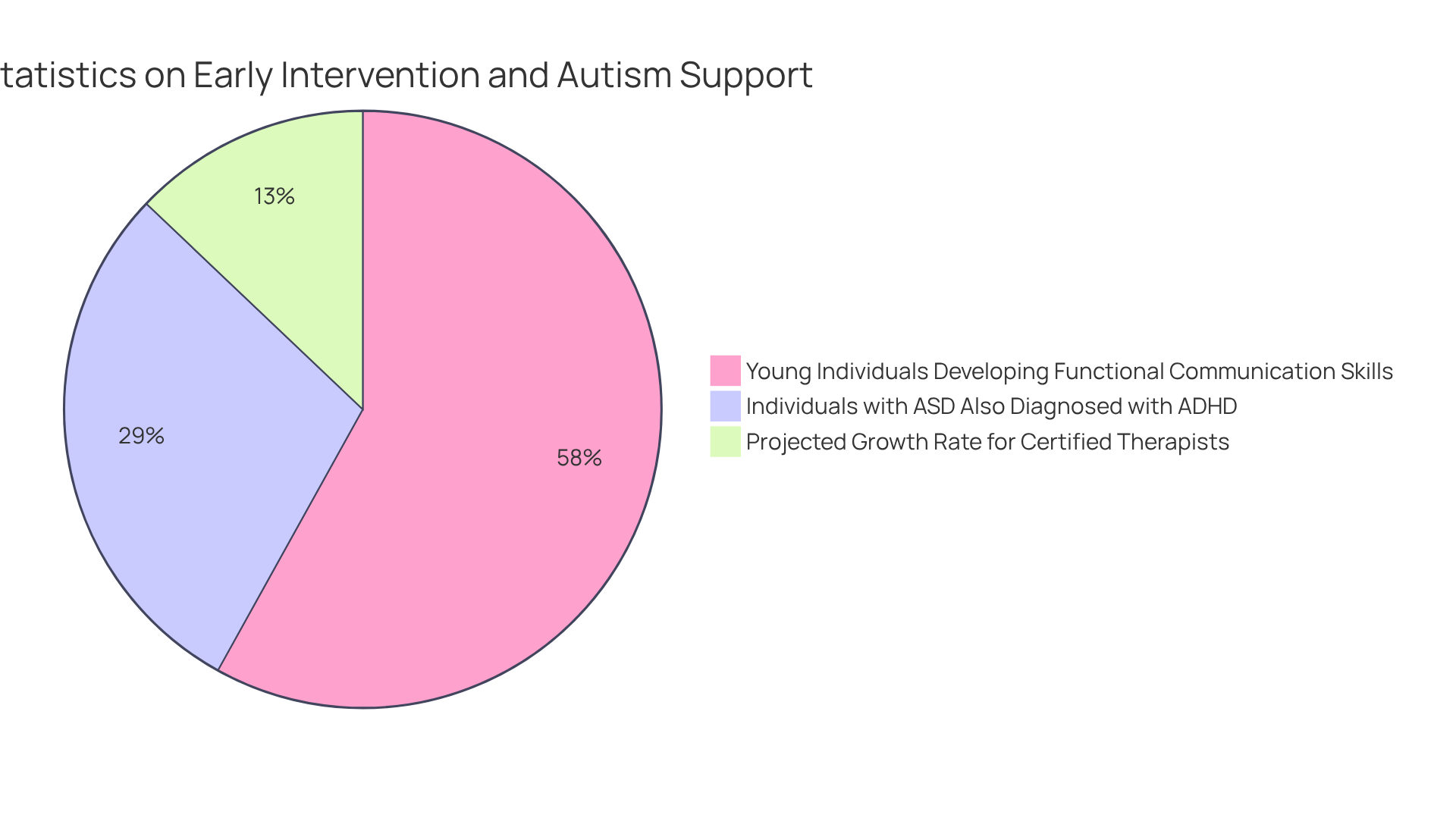
Social Skills Activities for Elementary Students with Autism: Engaging Strategies for Interaction
Engaging in interactive skills exercises is vital for fostering communication and connection among youngsters with autism. Role-playing games stand out as particularly effective tools, allowing young individuals to practice social situations in a safe and enjoyable setting. These games not only enhance communication skills but also promote turn-taking and empathy—key components of social interaction. Research indicates that role-playing games can significantly boost the development of interpersonal skills in children with autism. For instance, one study highlighted that children who participated in structured role-playing activities showed remarkable improvements in their ability to navigate social situations, showcasing the powerful role of play in education.
Beyond role-playing, group storytelling and interactive play sessions can further enrich the learning journey. These activities encourage teamwork and creativity, enabling young individuals to express themselves while learning to appreciate others' perspectives. Using puppets to act out different social scenarios is another engaging method that helps children grasp various reactions and emotions in relational contexts. Such strategies not only make learning enjoyable but also equip youngsters with the essential skills they need to engage more effectively with their peers.
Research has shown that children who take part in these activities often develop increased confidence in social settings, leading to improved interactions both in and out of the classroom. By incorporating these engaging methods into programs for kids with autism, parents and educators can create supportive environments that foster meaningful social connections for children with developmental disorders. Furthermore, with 36.5% of autism caregivers utilizing ABA therapy, structured activities like role-playing can be a crucial element of effective intervention strategies.
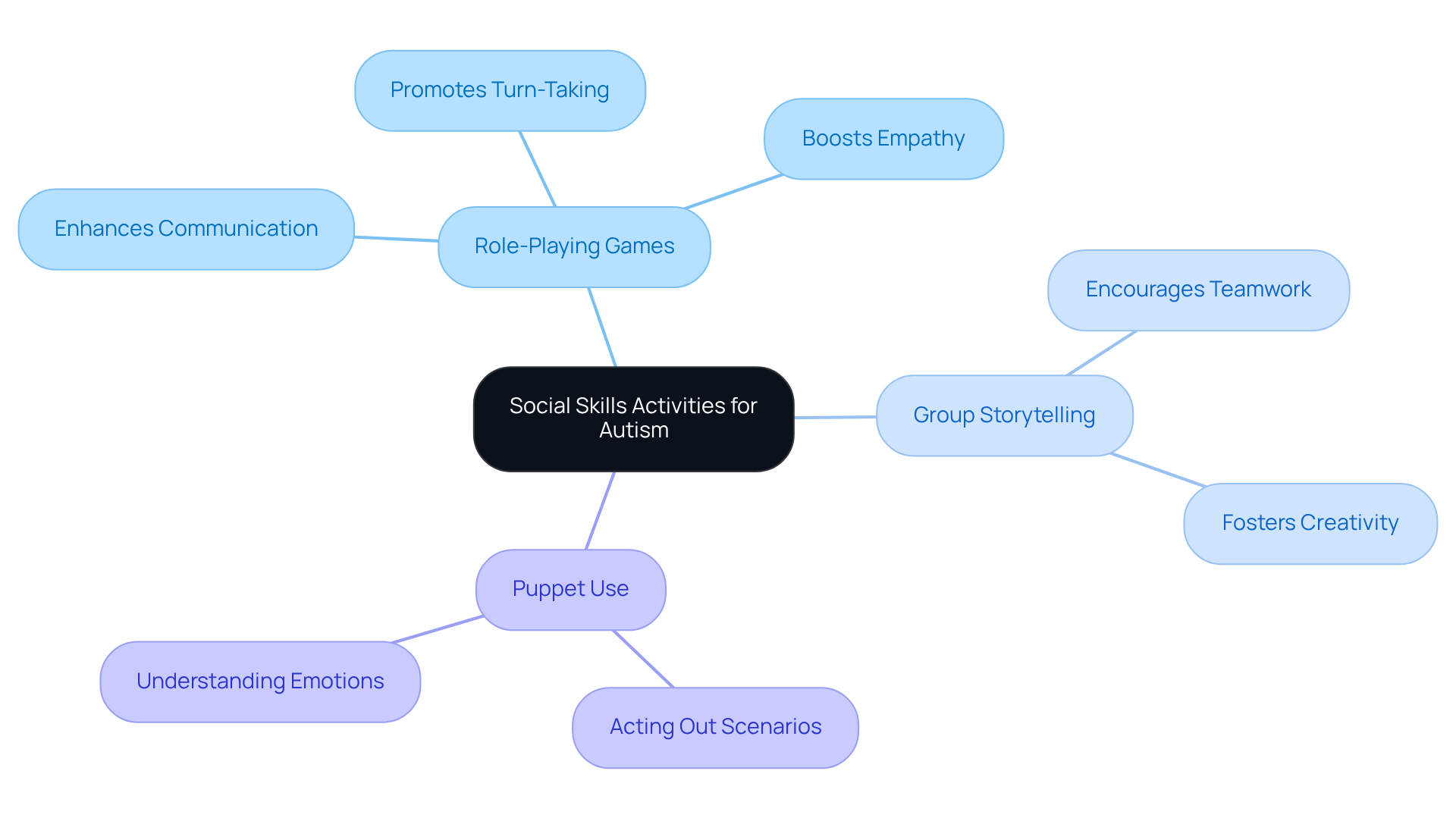
Sensory Activities for Children with Autism: Tools for Emotional Regulation and Engagement
Sensory experiences, such as sensory bins filled with rice or beans, water play, and tactile art projects, offer wonderful opportunities for children to explore different textures and sensations. These activities not only provide a soothing effect but also support the development of fine motor skills and creativity.
For instance, creating a 'calm-down' sensory box filled with items like:
- Stress balls
- Fidget spinners
- Textured fabrics
can empower young ones with tools to self-soothe during challenging moments.
How have you seen your child respond to sensory play? Sharing your experiences can help others find similar solutions.
Building a Skillset for Flexible Thinking: Strategies for Cognitive Development in Autism
To nurture adaptable thinking in children with autism, engaging in 'What If' scenarios can be particularly beneficial. These activities invite young individuals to explore various outcomes in different situations, enhancing creativity and problem-solving skills. For example, posing questions like, 'What if we could fly?' encourages imaginative thinking and helps children consider diverse perspectives.
Moreover, games that involve changing rules or roles, such as 'Simon Says' with unique commands, provide opportunities for children to practice adjusting to new circumstances. This not only boosts their cognitive flexibility but also strengthens their ability to handle unexpected changes.
Research indicates that programs for kids with autism that promote flexible thinking can lead to better outcomes, as these children learn to navigate social interactions and daily challenges more effectively. Psychologists emphasize that such cognitive development exercises, including programs for kids with autism, are crucial for fostering resilience and adaptability in children with developmental disorders, ultimately supporting their growth and success.
Additionally, statistics reveal that over 80% of families report enhanced quality of life and reduced stress levels after participating in programs for kids with autism, underscoring the significance of these activities. Including insights from specialists, like Dr. Stephen Shore, who states, 'if you've met one individual with this condition, you've met one individual with this condition,' highlights the need for tailored strategies for cognitive development.
Furthermore, referencing case studies such as Ethan's Early Intervention Journey, where structured programs led to a 70% decrease in frustration and tantrums, illustrates the tangible impact of these strategies.
To effectively implement 'What If' scenarios, parents can weave them into daily routines by asking open-ended questions during playtime or family discussions, creating an atmosphere of creativity and exploration.
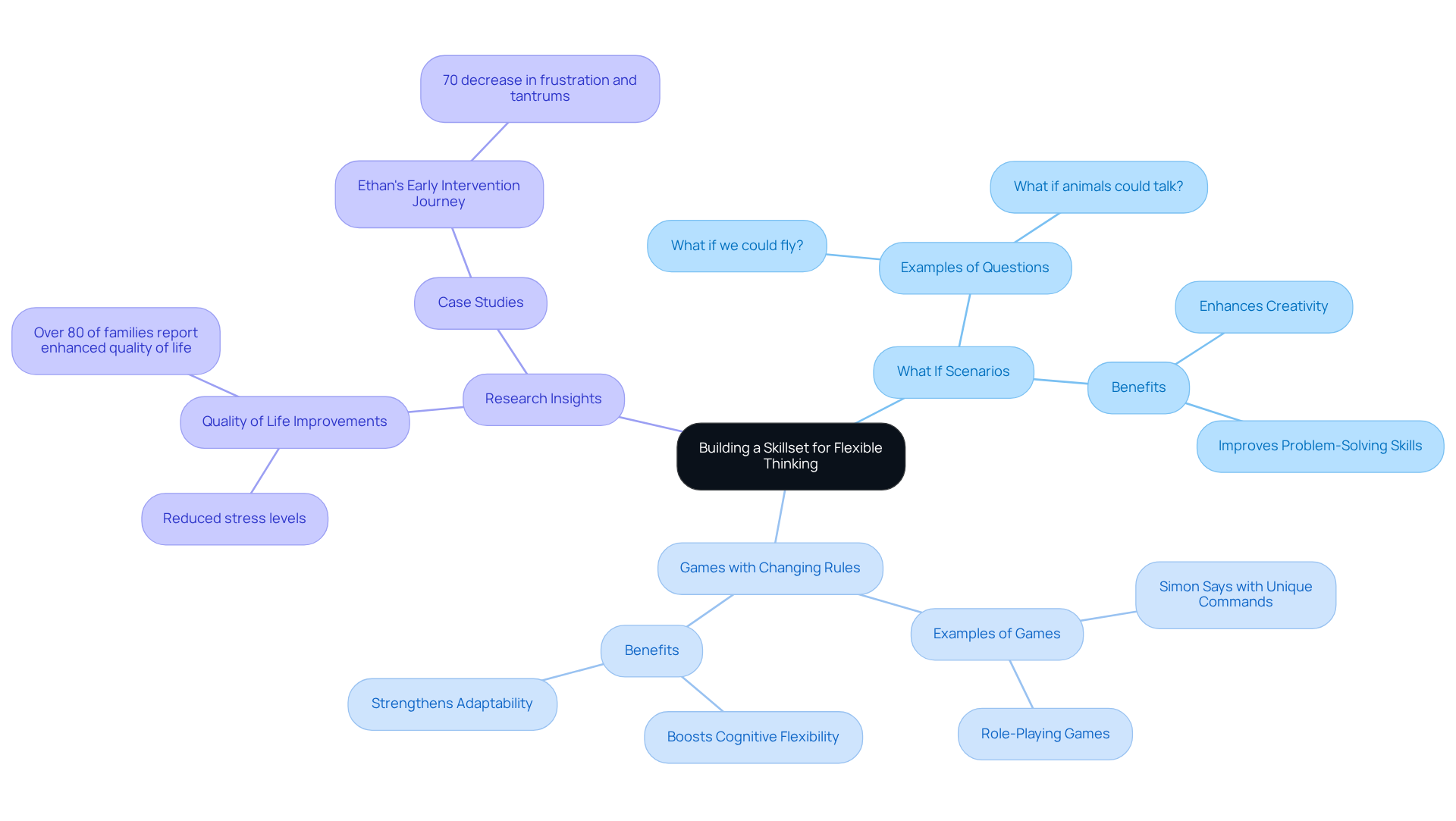
Mindfulness Exercises for Children with Autism: Techniques for Calmness and Focus
Mindfulness practices, such as deep breathing, guided imagery, and basic yoga poses, are invaluable tools for helping individuals with autism cultivate self-awareness and achieve a sense of tranquility. One delightful technique is 'bubble breathing,' where children visualize blowing bubbles as they exhale, turning deep breathing into a fun and engaging activity. This approach not only fosters relaxation but also enhances focus and emotional regulation. In fact, research shows that just five minutes of deep breathing can help children feel centered and aware.
Visual aids, like calm-down jars filled with glitter, serve as captivating focal points during mindfulness sessions, allowing young individuals to concentrate their attention and effectively manage their emotions. Therapists have noticed that incorporating these techniques into therapy sessions significantly boosts young people's ability to self-regulate and handle stress, creating a more positive therapeutic environment. Furthermore, regular practice of deep breathing methods has been shown to reduce anxiety and enhance overall well-being in youth with developmental disorders, making them valuable programs for kids with autism in various therapeutic approaches.
Structured routines, as highlighted in various sources, further bolster these mindfulness practices by providing predictability and security—key elements for managing emotions and behaviors. By exploring these mindfulness techniques, parents can support their children's emotional growth and well-being, fostering a nurturing environment that encourages self-awareness and resilience.

Use Visual Learning Aids: Enhancing Comprehension for Children with Autism
Visual learning tools, such as picture schedules, graphic organizers, and flashcards, can significantly enhance understanding in programs for kids with autism. Imagine how a visual timetable outlining daily tasks can help children anticipate transitions and reduce anxiety. This simple yet effective strategy, akin to programs for kids with autism, not only eases their daily routines but also empowers them to navigate their environments with confidence.
Furthermore, incorporating visual supports in programs for kids with autism—like using diagrams to clarify complex concepts—makes learning more accessible and engaging. Have you ever noticed how a well-placed image can spark curiosity? These tools can transform the learning experience, making it not just educational but also enjoyable. We encourage you to explore these resources and share your experiences with others, fostering a community of support and understanding.
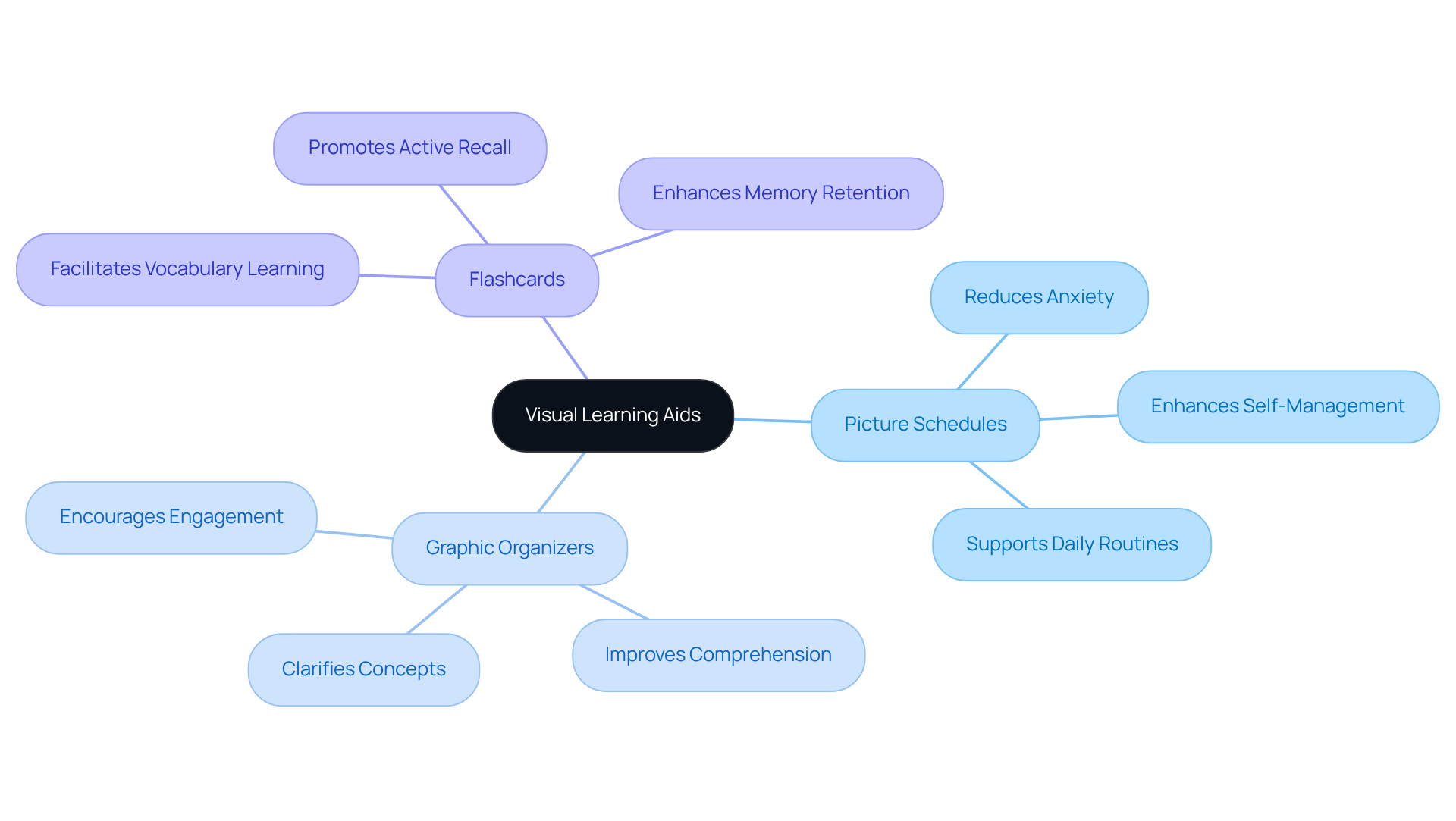
Create and Share a Daily Classroom Routine: Establishing Predictability for Autism Support
Creating a daily classroom routine that includes visual schedules and regular timing for tasks is essential for supporting programs for kids with autism. Imagine a sizable wall calendar that clearly outlines daily tasks and transitions; this not only provides clarity but also significantly reduces uncertainty. Research indicates that predictable routines can alleviate anxiety, allowing children to focus more effectively on their assignments. For instance, a case study on the use of visual schedules in a classroom setting revealed that students who adhered to a structured routine experienced a remarkable 30% decrease in anxiety-related behaviors.
Additionally, incorporating regular breaks and sensory activities into the routine can enhance engagement and help maintain attention throughout the day. Successful implementations of visual schedules in classrooms have shown that they foster a sense of security, enabling students to anticipate what comes next and reducing the likelihood of emotional outbursts. As one dedicated educator shared, 'Visual schedules empower students by giving them a clear understanding of their day, which is crucial for their emotional well-being.' This insight aligns with findings that highlight how visual aids, such as picture schedules, effectively diminish anxiety and promote independence.
By emphasizing predictability and organization, while recognizing the vital role caregivers play in establishing these routines, educators can create an environment through programs for kids with autism where children with developmental challenges can truly thrive. If you’re a parent or educator, consider implementing these strategies to support the emotional well-being of your students. Together, we can make a difference in their lives.

Hold Professional Development Sessions on Autism: Enhancing Educator Skills and Knowledge
Conducting professional development sessions centered on this condition can significantly enhance educators' understanding of effective teaching methods and behavioral interventions. Workshops that explore sensory integration, communication techniques, and individualized education plans (IEPs) empower teachers to cultivate more inclusive and supportive classroom environments. For instance, inviting guest speakers who specialize in developmental disorders can provide invaluable insights and practical tools for educators. Research reveals that schools with robust advocacy programs for individuals on the spectrum see a 59% reduction in bullying rates, highlighting the positive influence of well-informed educators on student well-being.
Moreover, effective teaching strategies for individuals on the autism spectrum in 2025 underscore the importance of personalized methods, particularly focusing on sensory integration techniques that cater to the unique needs of autistic learners. Notably, 91% of specialists in the field regard person-centered approaches as the most effective, reinforcing the necessity of ongoing professional development. By prioritizing culturally relevant methods and seeking specific programs for kids with autism, educators can enhance learning experiences that promote the growth and success of children with special needs. As Temple Grandin wisely states, 'Different, not less,' reminding us of the profound value in understanding and supporting autistic students.

Activities for Autism Acceptance Month: Fostering Community Awareness and Support
During Autism Acceptance Month, organizing community events such as awareness walks and educational workshops can truly foster understanding and acceptance of autism. Schools can play a pivotal role by hosting assemblies that educate students about the condition and nurture empathy. For instance, imagine a 'Wall of Acceptance' where students share messages of support; this can create a profound sense of community and belonging.
Educational workshops have shown remarkable effectiveness in raising awareness. They not only provide valuable insights into autism but also empower participants to advocate for individuals on the spectrum. The impact of these workshops is significant, encouraging dialogue and understanding—elements that are essential for nurturing supportive environments.
As Christopher Banks, President and CEO of the Autism Society of America, emphasizes, enhancing access to quality supports and services is crucial in addressing the rising prevalence of autism, which currently affects 1 in 36 children. By participating in these community-focused initiatives, we can collectively strive for a more inclusive society that acknowledges and celebrates the unique strengths of individuals on the spectrum.
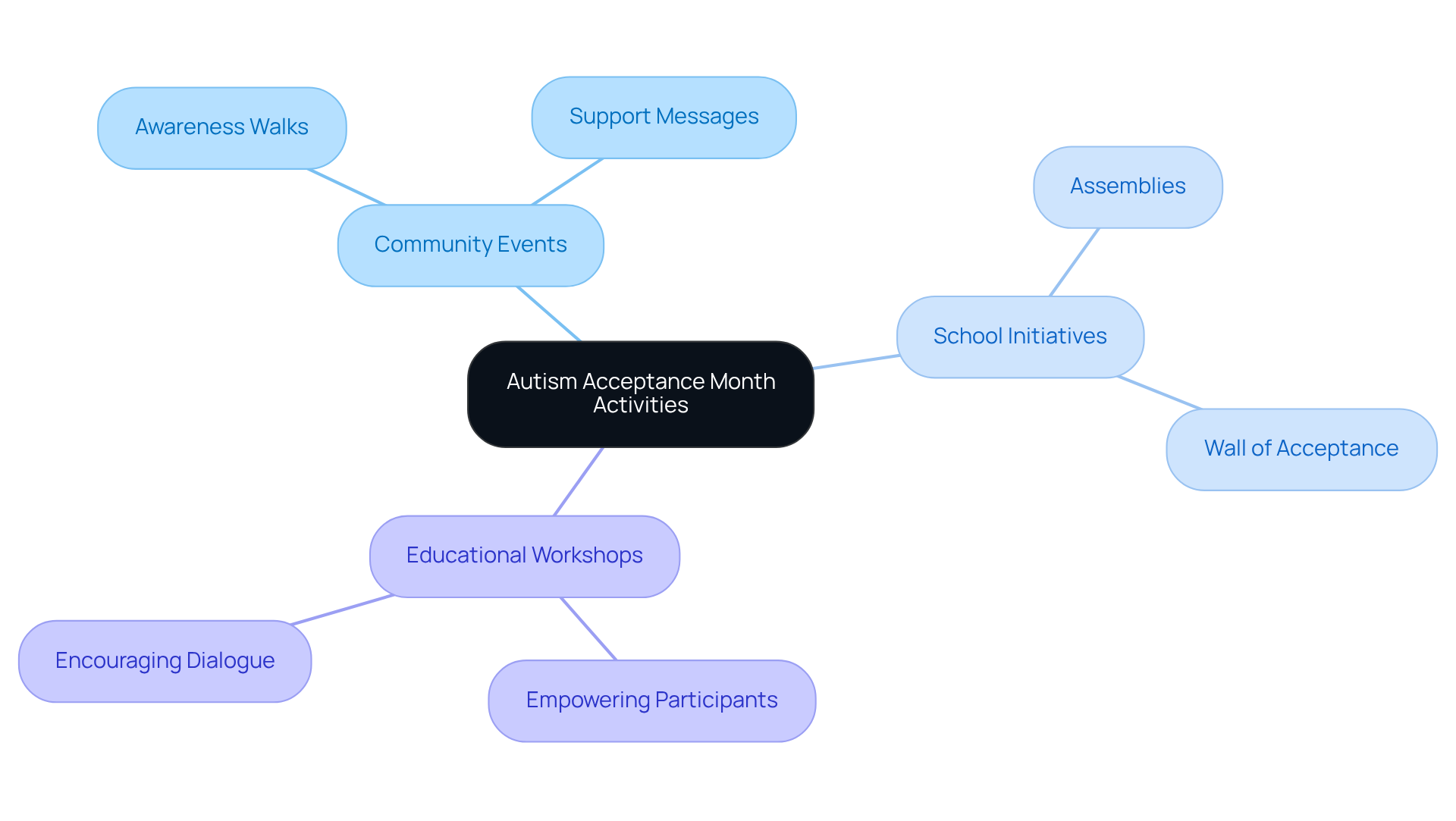
Teach Students About Famous and Historical Autistic Figures: Inspiring Understanding and Empathy
Introducing students to remarkable historical figures who have developmental differences, like Albert Einstein and Temple Grandin, serves as a powerful way to nurture understanding and empathy. By delving into the contributions of these individuals, educators can help students appreciate the diverse talents and perspectives within the autism community.
For instance, consider assigning a project where students research and present on an autistic figure. This not only enhances engagement but also cultivates a deeper appreciation for the unique experiences of individuals on the spectrum.
Such an approach underscores the significance of relatable role models while imparting valuable lessons in empathy and acceptance. Together, we can foster a more inclusive environment for all.
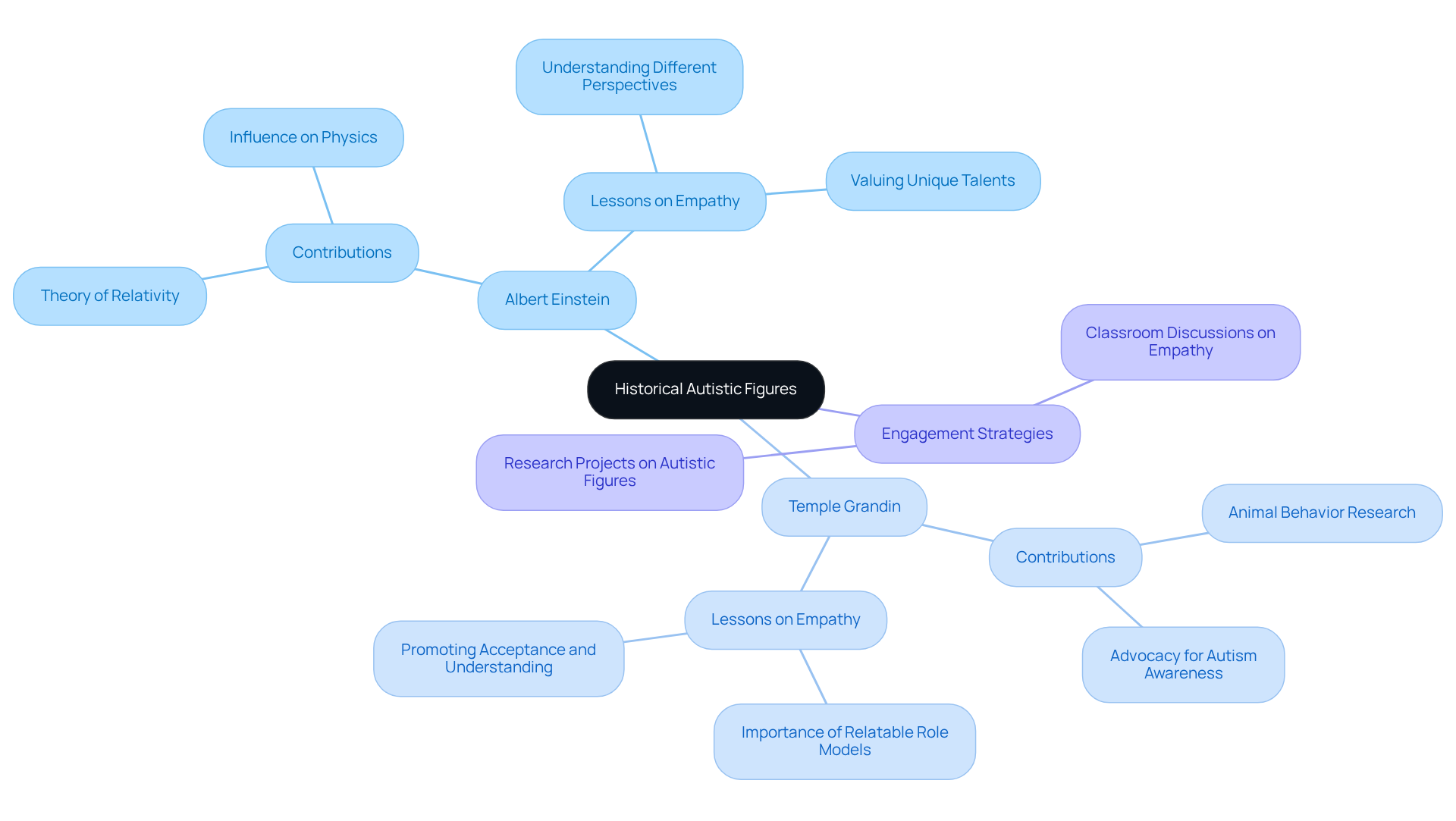
Conclusion
The exploration of programs designed for children with autism highlights the profound impact that tailored interventions can have on their development and well-being. By focusing on enhancing social skills, emotional regulation, cognitive flexibility, and community awareness, these programs empower children to thrive in various environments, nurturing their unique strengths and abilities.
Key insights from the article emphasize the importance of:
- Early intervention
- Personalized approaches
- Community involvement
Engaging activities such as:
- Role-playing
- Sensory experiences
- Mindfulness exercises
not only enhance communication and emotional regulation but also contribute to a more inclusive society. Moreover, the role of educators and caregivers is vital in creating supportive environments where children can explore their potential and build meaningful connections.
As we collectively recognize the value of diverse learning strategies and the significance of autism acceptance, it becomes essential to advocate for these programs and support initiatives that promote understanding and inclusion. Together, by implementing effective strategies and fostering community awareness, we can build a brighter future for children with autism, ensuring they receive the support they deserve to flourish.
Frequently Asked Questions
What is ASD Media and its mission?
ASD Media is an organization focused on enhancing ABA therapy implementation by providing insights and strategies for parents and professionals supporting individuals with autism and related conditions. Its mission is to empower families and professionals with tools and resources to improve interpersonal skills development and overall quality of life for youngsters with ADHD.
How does early intervention impact individuals with autism?
Early intervention can lead to significant improvements in communication and social skills, with studies showing that up to 90% of young individuals receiving early intervention develop functional communication skills. Additionally, over 80% of families report enhanced quality of life and reduced stress following early intervention.
What are some effective strategies for managing challenging behaviors in children with autism?
ASD Media emphasizes the importance of tailored approaches that cater to each individual's unique strengths and needs. Effective strategies include personalized interventions and support services that address specific behavioral challenges.
What is the current job outlook for certified ABA therapists?
There is a growing demand for certified therapists in ABA therapy, with job growth projected to exceed 20% by 2029, reflecting an increasing recognition of the importance of community support for individuals with developmental disorders.
What are some engaging social skills activities for children with autism?
Engaging activities include role-playing games, group storytelling, interactive play sessions, and using puppets to act out social scenarios. These activities enhance communication skills, promote turn-taking, and foster empathy among children with autism.
How do sensory activities benefit children with autism?
Sensory activities, such as sensory bins, water play, and tactile art projects, help children explore different textures and sensations. They provide a soothing effect, support the development of fine motor skills, and can empower children with tools for emotional regulation.
What is the economic impact of developmental disorder care?
The economic implications are significant, with expenses expected to rise from $268 billion in 2015 to $461 billion by 2025, highlighting the urgent need for effective ABA therapy and community support for individuals with developmental disorders.




